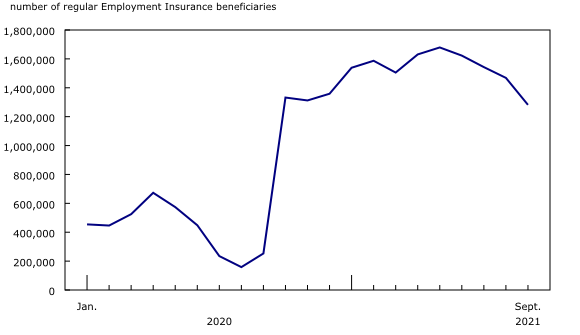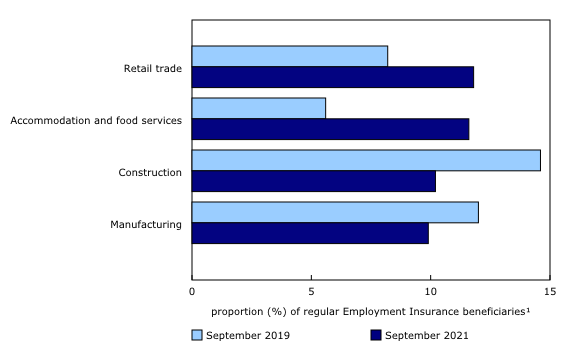Employment Insurance, September 2021
Archived Content
Information identified as archived is provided for reference, research or recordkeeping purposes. It is not subject to the Government of Canada Web Standards and has not been altered or updated since it was archived. Please "contact us" to request a format other than those available.
Released: 2021-11-18
The number of Canadians receiving regular Employment Insurance (EI) benefits dropped 187,000 (-12.7%) in September to 1.3 million. Ontario, Quebec and Alberta accounted for most of the national decrease.
Do you use labour market information as part of your work? Statistics Canada and the Labour Market Information Council are teaming up to gather feedback from professionals that are regularly using labour statistics, including journalists, policy analysts, sector association representatives, and career councillors, to assess their labour market information needs. Tell us what your priorities are and the gaps you face when using labour market information by answering a few questions. Your opinions will help shape action to address labour market information gaps.
September EI statistics reflect labour market conditions during the week of September 12 to 18.
By mid-September, several provinces had introduced, or planned to introduce, proof-of-vaccination requirements to enter non-essential businesses such as restaurants, bars and gyms. Alberta reintroduced an alcohol service curfew at restaurants, pubs and bars beginning September 4. In addition, employers in the province were urged to pause return-to-work plans. On September 14, Nova Scotia postponed entering its final phase of reopening.
Fewer Canadians collect regular EI benefits in September
Approximately 1.3 million Canadians received regular EI benefits in September, down 187,000 (-12.7%) from a month earlier.
According to the Labour Force Survey (LFS), employment rose by 157,000 in September, bringing employment back to the same level as February 2020, before the pandemic. Unemployment held steady in September at 1.4 million, including 1.3 million Canadians who were looking for work and 200,000 who had a connection to a job, because they were either on temporary layoff or had arrangements to begin a new job in the near future.
The decrease in regular EI beneficiaries concentrated in Ontario, Quebec and Alberta
The number of regular EI beneficiaries fell in seven provinces in September, led by Ontario (-98,000; -19.1%), Quebec (-40,000; -12.7%) and Alberta (-29,000; -16.2%). According to September LFS results, employment rose by 74,000 in Ontario, 31,000 in Quebec and 20,000 in Alberta.
In September, there were more regular EI beneficiaries in New Brunswick (+1,000; +1.5%), and little change in Newfoundland and Labrador and Nova Scotia, compared with August.
On a regional basis, the census metropolitan areas of Toronto (-54,000; -23.2%) and Montréal (-27,000; -18.0%) accounted for 43.5% of the monthly decrease in regular EI recipients.
EI recipients who last worked in sales and service occupations account for two-thirds of the monthly decline in regular EI beneficiaries
In September, the number of regular EI recipients declined in 9 of 10 broad occupational groups compared with August, with those who last worked in sales and service occupations (-124,000; -25.3%) accounting for two-thirds of the monthly decline. At the same time, more regular EI recipients last worked in occupations in education, law and social, community and government services (+22,000; +22.8%).
Just over half (52.4%) of regular EI recipients last worked in sales and service occupations or trades, transport and equipment operators and related occupations in September.
More than 4 in 10 regular EI recipients last worked in one of four industries
In September, 43.5% of regular EI recipients last worked in one of four industries, including 11.8% in retail trade; 11.6% in accommodation and food services; 10.2% in construction; and 9.9% in manufacturing (not seasonally adjusted). In September, the share of regular EI recipients who last worked in accommodation and food services was 6.0 percentage points higher (not seasonally adjusted) compared with September 2019. September LFS results showed that employment in these same four industries was 339,000 below pre-COVID February 2020 levels.
Bigger drop in regular EI beneficiaries among core-aged women than core-aged men
In September, the number of core-aged (25 to 54 years) women receiving regular EI benefits fell by 89,000 (-21.1%), a decrease almost 1.5 times larger than that among core-aged men (-63,000; -13.8%). September LFS results showed that employment rose by 86,000 among core-aged women and by 57,000 among core-aged men.
Women aged 55 years and older (+38,000; +24.4%) was the lone demographic group with more regular EI recipients in September compared with August. According to September LFS results, employment among older women (-2.2%) and young men aged 15 to 24 years (-2.2%) was further below February 2020 levels than all other demographic groups.
Long-term unemployment reflected in regular EI benefits
The September LFS showed that 27.3% of all unemployed had been continuously out of work for 27 weeks or more, compared with 15.6% before the pandemic in February 2020. This elevated level of long-term unemployment is reflected in regular EI data.
In September, more than two-thirds (69.0%) of EI recipients had received regular EI benefits or the Canada Emergency Response Benefit (CERB) in at least 7 of the last 12 months, up from 16.1% in February 2020 (not seasonally adjusted). Over two-thirds of women (69.2%) and men (68.8%) received regular EI benefits or CERB in at least 7 of the last 12 months. Among longer-term regular EI recipients, over half (56.6%) were core-aged (aged 25 to 54 years), similar to the share of this age group among the long-term unemployed as measured by the LFS. By province, the proportion of EI recipients who had received regular EI benefits or CERB in at least 7 of the last 12 months ranged from 64.8% in Nova Scotia to 71.4% in Ontario.
Next release
October EI results will reflect the impact on the profile of regular EI recipients following changes to regular EI eligibility criteria, including an increase in the number of insured hours required, introduced on September 26, 2021.
Sustainable Development Goals
On January 1, 2016, the world officially began implementing the 2030 Agenda for Sustainable Development, the United Nations' transformative plan of action that addresses urgent global challenges over the following 15 years. The plan is based on 17 specific sustainable development goals.
Employment Insurance statistics are an example of how Statistics Canada supports reporting on global sustainable development goals. This release will be used to help measure the following goal:

Note to readers
Employment Insurance in the context of broader COVID-19 benefit programs
No methodological changes were made to the Employment Insurance Statistics (EIS) program over the COVID-19 pandemic period. EIS reflect the Employment Insurance (EI) program for the Labour Force Survey (LFS) reference week in each month.
Data for the October 2020 reference period and onward comprise individuals who obtained EI benefits and exclude beneficiaries of the Canada recovery benefits (Canada Recovery Benefit, Canada Recovery Caregiving Benefit, and Canada Recovery Sickness Benefit).
Concepts and methodology
The analysis focuses on people who received regular EI benefits related to job loss.
EI statistics are produced from administrative data sources provided by Service Canada and Employment and Social Development Canada. These statistics may, from time to time, be affected by changes to the Employment Insurance Act or administrative procedures.
EI statistics indicate the number of people who received EI benefits and should not be confused with LFS data, which provide estimates of the total number of unemployed people. There is always a certain proportion of unemployed people who do not qualify for benefits. Some unemployed people have not contributed to the program because they have not worked in the past 12 months or their employment was not insured. Other unemployed people have contributed to the program, but do not meet the eligibility criteria, such as workers who left their jobs voluntarily or those who did not accumulate enough hours of work to receive benefits.
All data in this release are seasonally adjusted, unless otherwise specified. Values for all series from March 2020 to September 2021 have been treated as outliers in determining a seasonal pattern for seasonal adjustment. For more information on seasonal adjustment, see Seasonally adjusted data – Frequently asked questions.
The number of regular EI beneficiaries for the current month and the previous month is subject to revision.
The number of beneficiaries is a measure of all people who received regular EI benefits from September 12 to 18. This period coincides with the reference week of the LFS.
Beneficiaries who qualified for EI under the new EI rules introduced in September 2020
Temporary changes to the EI program that provided all new regular EI beneficiaries with a one-time credit of 300 insurable hours were introduced on September 27, 2020. In addition, the unemployment rate used to calculate their eligibility and entitlement weeks was 13.1%, unless their region's unemployment rate was higher.
This supplementary indicator presents the number of individuals who qualified for EI, only as a result of these program changes.
EI beneficiaries by industry
The industry of EI beneficiaries is determined by integrating EI data with record of employment administrative data. For beneficiaries with more than one record of employment in the 52 weeks prior to the reference week, the records with the greatest number of hours are used. If no industry information can be found, industry information is deemed "Not classified" for the beneficiary.
EI beneficiaries by number of months on EI or Canada Emergency Response Benefit over the previous 12 months
This supplementary indicator presents the number of regular EI recipients who received either regular EI benefits or the Canada Emergency Response Benefit (CERB) for a defined number of months over the previous 12 months.
A census metropolitan area (CMA) or census agglomeration (CA) is formed by one or more adjacent municipalities centred on a population centre. A CMA must have a total population of at least 100,000. A CA must have a population of at least 10,000. See Standard Geographical Classification 2016 – Definitions for more information.
Data availability
In the data tables 14-10-0004, 14-10-0005, 14-10-0007 and 14-10-0008, for the March to September 2020 reference periods, data have been suppressed because a source data file contains records for CERB claimants and beneficiaries who could not be identified and excluded through processing.
Next release
Data on EI for October will be released on December 16, 2021.
Products
More information about the concepts and use of Employment Insurance statistics is available in the Guide to Employment Insurance Statistics (73-506-G).
Contact information
For more information, or to enquire about the concepts, methods or data quality of this release, contact us (toll-free 1-800-263-1136; 514-283-8300; STATCAN.infostats-infostats.STATCAN@canada.ca) or Media Relations (613-951-4636; STATCAN.mediahotline-ligneinfomedias.STATCAN@canada.ca).
- Date modified:





